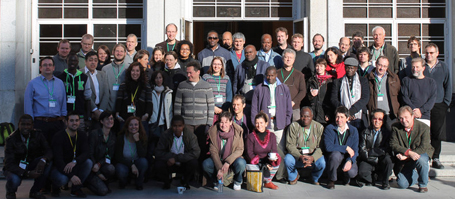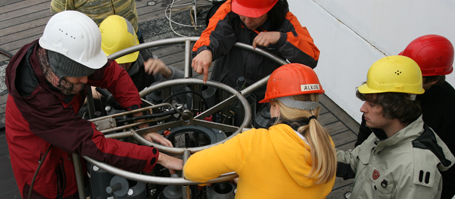Schleswig-Holstein is the land in between the seas. But this northernmost state is not only dominated by the seas geographically: The sea plays a major role in business, culture and science as well. This is also reflected in Schleswig-Holstein's presence at the official celebrations of the Day of German Unity on October 2nd and 3rd in Stuttgart. In Schleswig-Holstein’s presentation on the so-called Mile of German States (“Ländermeile”), an exhibition of the Cluster of Excellence "The Future Ocean" and GEOMAR Helmholtz Centre for Ocean Research Kiel leads visitors into the dark and mysterious deep sea where they can explore unknown regions of our planet and learn how scientists explore these regions today.
Diving into unknown worlds: The unique "Kiel World Relief" and an unusual globe give visitors a first impression of what the surface of our planet really looks like - even where we can only see water on conventional world maps. "Mountains and canyons are not restricted to land alone. Towering mountain ranges and deep trenches also meander through the oceans. They not only present an interesting underwater topography but also tell a lot about the forces acting within the Earth," explains Dr. Gerd Hoffmann-Wieck, geologist and exhibition coordinator at GEOMAR.
Surrounding these central exhibits are groups of additional current topics in marine research, some of them presented as interactive modules. Visitors can learn how modern scientists receive information from the ocean interior to better understand natural climate variability and predict future climate changes. One vital topic for many sea creatures is ocean acidification and its effect on the survival of these species. “We can explain to visitors the not so well-known effect of high carbon dioxide emissions, what consequences it has and how we explore the issue," says Dr. Hoffmann-Wieck.
Fishing is also a central issue: How much are fish stocks overfished? What fish can I eat with a clear conscience? And how could fishermen earn more with careful use of existing stocks? - Kiel marine researchers are presenting new results of interdisciplinary research in Stuttgart.
Original samples from the sea floor give visitors a direct view of the strange and fascinating world of the seabed: A drill core from the Baltic or a piece of lava from deep waters off the Cape Verde Islands. Original and model versions of complex research equipment give an impression of the technical effort needed to explore and understand the largest habitat on Earth.
Employees of GEOMAR and the Cluster of Excellence "The Future Ocean" are available during the opening hours of the tent, 11 am to 11 pm each day, to answer questions and to provide in-depth information on the exhibition. "Visitors can use our guest book to note whether or not they liked the show. They may also ask questions on the subject of the sea which will then be answered in the coming weeks on our Kiel marine research blog www.oceanblogs.org," said Dr. Hoffmann-Wieck.
The entire team is looking forward to many visitors, interesting questions and stimulating discussions in Stuttgart.
Contact:
Dr. Gerd Hoffmann-Wieck (GEOMAR, Communication & Media), +49-431 600 2555
ghoffmann-wieck@geomar.de
Annika Wallaschek, Ausstellungskoordination, Cluster of Excellence "The Future Ocean" , Tel.: 0431-880-4726
awallaschek@uv.uni-kiel.de
…



